Mastering the Art of Snaking a Shower Drain
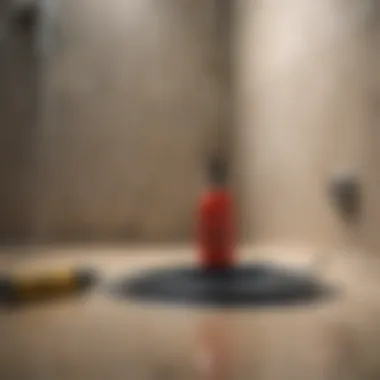
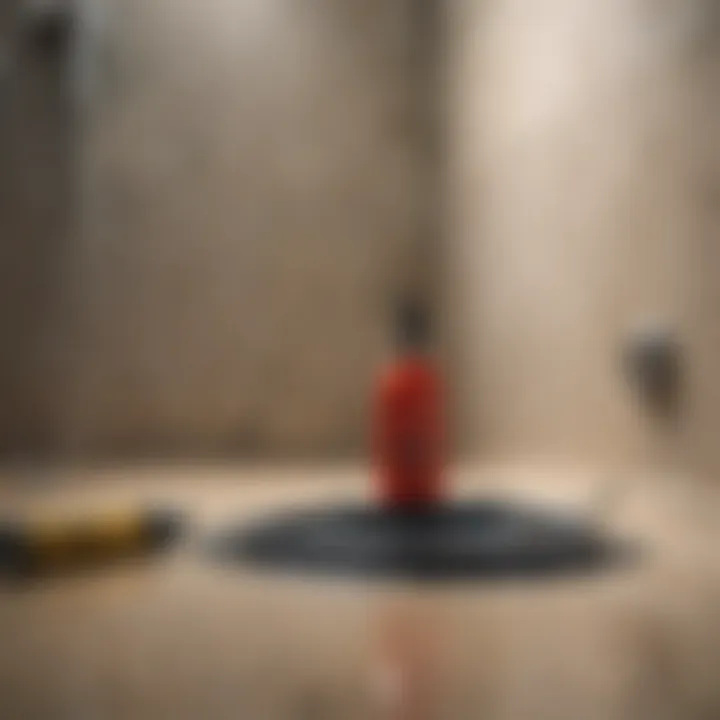
Intro
Maintaining a functional and efficient shower drain is a crucial aspect of household care. Often, shower drains can become clogged due to hair, soap residue, and other debris, leading to poor drainage and undesirable odors. The importance of snaking a shower drain is often underestimated. This method offers a practical solution to this common problem without needing a professional plumber.
This guide seeks to illuminate the principles of snaking a shower drain, detailing necessary tools, techniques, and troubleshooting strategies. Homeowners and DIY enthusiasts looking to preserve their bathrooms' efficiency will find value in understanding these processes.
Tools for Snaking a Shower Drain
Equipping oneself with the proper tools is essential before attempting to snake a shower drain. Successful snaking can be achieved with a few straightforward items:
- Drain Snake: A flexible tool designed to navigate through pipes, dislodging clogs.
- Gloves: Protects hands from potential debris and bacteria.
- Bucket: To catch any water or debris that may escape the drain during the process.
- Protective Eyewear: Important for safety when working in tight spaces where debris may fly out unexpectedly.
Having these tools at hand sets the foundation for a more effective and hygienic cleaning session.
Common Causes of Shower Drain Clogs
Understanding the factors that lead to drain issues is essential. Here are some typical causes:
- Hair Buildup: Long hair tend to accumulate and create clogs.
- Soap Scum: Lathering agents can solidify, combining with hair to block passageways.
- Mineral Deposits: Hard water can lead to mineral mining within the pipes.
Recognizing these causes allows homeowners to be proactive, implementing preventive measures to reduce the likelihood of future clogs.
The Snaking Process
The actual process of snaking a shower drain requires careful attention to ensure thoroughness. Here are the steps involved:
- Remove the Drain Cover: Use a screwdriver if necessary.
- Insert the Drain Snake: Gently push the snake into the drain until you encounter resistance, which indicates a clog.
- Dig and Rotate: Turn the snake to break apart the clog, allowing it to dislodge.
- Pull Back Debris: As the snake extracts debris, be ready with your bucket.
- Flush the Drain: Finally, run hot water through the drain for about 10 minutes to wash away remaining residue.
This structured approach ensures that most standard clogs can be handled effectively, reinstating the drain's functionality.
Culmination
Snaking a shower drain is an invaluable skill for any homeowner. With proper tools, an understanding of common clog causes, and a systematic approach to the snaking process, the task transforms from daunting to manageable. Mastery over such household maintenance not only potentially saves on repair costs but also enhances the enjoyment of the bathing experience.
Remember: Regular maintenance can prevent clogs from developing in the first place.
Understanding Drain Clogs
In order to effectively address shower drain issues, it is crucial to grasp the concept of drain clogs and what causes them. Knowledge about the nature and origin of drain blockages allows homeowners and enthusiasts to take preventive measures and manage clogs before they become severe. Understanding drain clogs signifies the first line of defense in maintaining optimal drainage function, saving both time and money in repairs.
Nature of Shower Drain Blockages
Shower drain blockages usually arise from a combination of hair, soap residues, skin cells, and other debris. Hair tends to form tangled masses that can easily catch other materials, leading to a significant clog. Soap scum, composed of fats and oils, adheres to the walls of drain pipes, hardening over time and constricting the flow of water. These blockages can range from minor inconveniences, which may cause slow drainage, to serious obstructions that completely halt water flow.
Identifying the nature of these blockages helps in tailoring appropriate solutions. For instance, if the clog involves predominantly hair, a specific type of drain snake designed for hair removal would be most effective. Similarly, understanding how debris accumulates within the pipes can inform regular maintenance practices, ensuring the longevity of the drain system.
Impact of Clogs on Bathroom Functionality
Understanding the impact of drain clogs goes beyond just the immediate scenario of water retention. Clogs in the shower drain can severely affect the overall functionality of the bathroom. When water cannot drain properly, it creates a breeding ground for bacteria and mold. This situation poses health risks and necessitates more extensive cleaning processes.
Furthermore, persistent clogs can lead to overflow situations. This may cause water damage to bathroom flooring and walls, requiring costly repairs. Homeowners may also experience inconvenience during their daily routines, resulting in lowered property value if the issues escalate.
In summary, understanding drain clogs is a foundational component of effective drain maintenance. By recognizing the nature of blockages and their impact on bathroom functionality, individuals can prioritize timely intervention and ensure the hygiene and structural integrity of their living space.
Effective drain maintenance not only preserves functionality but also contributes to a healthier living environment.
Prolusion to Snaking
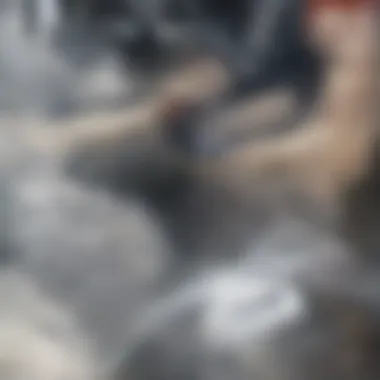
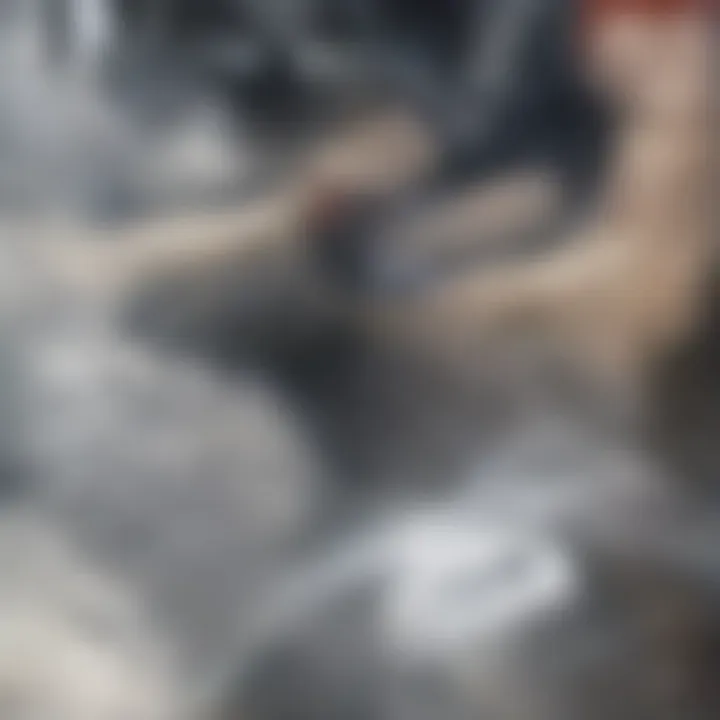
In the realm of home maintenance, understanding the technique of snaking a shower drain is crucial. This process not only helps to alleviate immediate plumbing issues but also enhances the longevity of your drainage system. Individuals who prioritize home upkeep will benefit from mastering the art of snaking as it empowers them to tackle common plumbing challenges independently. Moreover, performing snaking can save homeowners money in repair costs and prevent the frustration of repeated clogs.
What is Snaking?
Snaking refers to the practice of using a specialized tool, known as a drain snake, to clear blockages from drains and pipes. This tool comes in various forms, including manual augers and electric snakes. The primary function of a snake is to navigate through the curves and angles of plumbing systems, allowing it to reach and dislodge debris that may be obstructing flow. This process is often seen as a preventative measure, helping to maintain optimal drainage conditions.
History of Drain Snakes
The concept of snaking drains has a long and practical history. While exact origins can be difficult to trace, records indicate that early forms of drain cleaning tools appeared in the 19th century. These initial drain snakes were rudimentary, often made from simple metal strips. Over time, the design evolved significantly. Modern drain snakes are now crafted from a variety of materials, including flexible cables capable of reaching deep into pipes. The evolution of these tools reflects a continuous effort to improve efficiency in managing home plumbing systems, making drain snaking an essential skill for homeowner and property enthusiast alike.
Tools Required for Snaking a Drain
Understanding the tools required for snaking a drain is essential for both effective maintenance and efficient resolution of clogs. Using the right tools not only facilitates the process but also ensures that the issue is addressed without causing further damage to the drainage system. A properly equipped individual will have a higher rate of success during the snaking process, making it a crucial section in any discussion about shower drain maintenance.
Types of Drain Snakes
Several types of drain snakes can be used, each serving a different purpose based on the specific requirements of the clog. Among these, a few common types include:
- Handheld Drain Snakes: These are typically made of flexible metal or plastic and come with a coiled end. They are easy to use for minor clogs close to the drain entry.
- Electric Drain Snakes: These are more powerful and are designed to handle tougher clogs which cannot be removed manually. They are often equipped with a motor to drive the snake through the plumbing with ease.
- Toilet Augers: While primarily for toilets, these specialized snakes can also be effective in shower drain situations when the obstruction is deep within the pipes.
- Drain Cleaning Cables: These cables come in various thicknesses and lengths, making them suitable for different types of drains. The thicker the cable, the better it is for breaking through heavy blockages.
Choosing the right type of drain snake depends on the severity of the clog and the layout of the drainage system. Proper assessment of the situation before selecting a snake can save time and effort.
Additional Tools to Consider
Alongside the drain snake, several additional tools can enhance the snaking process. These may include:
- Plumber's Tape: Useful for sealing connections and preventing leaks after snaking.
- Bucket: Handy for collecting water or debris that may come out during the snaking process, thus keeping the area clean.
- Gloves: Always recommended for hygiene, gloves protect your hands from debris and chemicals that may be present.
- Flashlight: Providing visibility in dark or cramped spaces increases safety and effectiveness during the process.
- Basin Wrench: Especially helpful for accessing the drain trap if you need to take it apart during severe clogs.
Having a well-rounded toolkit ready not only maximizes efficiency but enhances safety throughout the procedure. By integrating these tools, individuals can navigate their drain issues more effectively, maintaining a more functional household.
Preparation for Snaking
Preparation is a critical phase in the snaking process, often overlooked by many. Proper preparation sets the groundwork for successful drain maintenance. Without a careful approach, one can encounter setbacks that prolong the task or worsen the existing issues. Preparing adequately not only enhances effectiveness but also promotes safety, allowing for a smoother experience during and after snaking.
Gathering Necessary Supplies
Before diving into the actual snaking, it is essential to gather all necessary supplies. Having everything at hand minimizes interruptions during the process. It is beneficial to include the following items:
- Drain snake: Choose the appropriate type based on the clog's location and severity. A manual snake is suitable for minor obstructions, while a powered snake may be needed for more stubborn clogs.
- Gloves: Disposable gloves are crucial for hygiene and protection against debris and chemicals.
- Bucket or towels: To catch any water or debris that may spill out during the process.
- Plumbing auger: Helpful if the drain snake struggles to break through tough clogs.
These tools ensure you are ready for any situation that may arise during the snaking.
Inspecting the Shower Drain
Once necessary supplies are gathered, the next step is inspecting the shower drain. This step provides insights into the clog's nature and location. A thorough inspection helps identify any issues that may complicate the snaking process. Here are some key points to consider:
- Debris accumulation: Visual examination can reveal hair, soap scum, or foreign objects trapped in the drain. Removing visible debris can help facilitate the subsequent snaking process.
- Water standing: Assess if water collects in the drain when running. This can indicate the severity of the clog.
- Pipe condition: Look for any signs of damage or corrosion on the visible pipes.
"Even minor defects in a drain can lead to significant issues later. Be thorough in your inspection."
In essence, being meticulous during the inspection allows you to tailor your approach effectively, saving time and effort as you navigate the challenges of snaking a shower drain.
Step-by-Step Snaking Process
The process of snaking a shower drain is crucial for maintaining a functional and efficient bathroom environment. Knowing how to adequately perform this task can save homeowners both time and money by preventing more severe plumbing issues. Understanding the essential steps helps ensure that the drain is unclogged without causing damage. The step-by-step approach allows for systematic tackling of clogs and offers confidence to those unfamiliar with plumbing tasks.
Inserting the Drain Snake
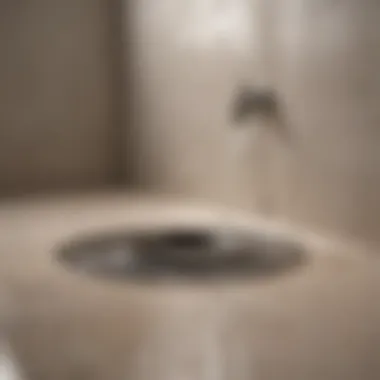
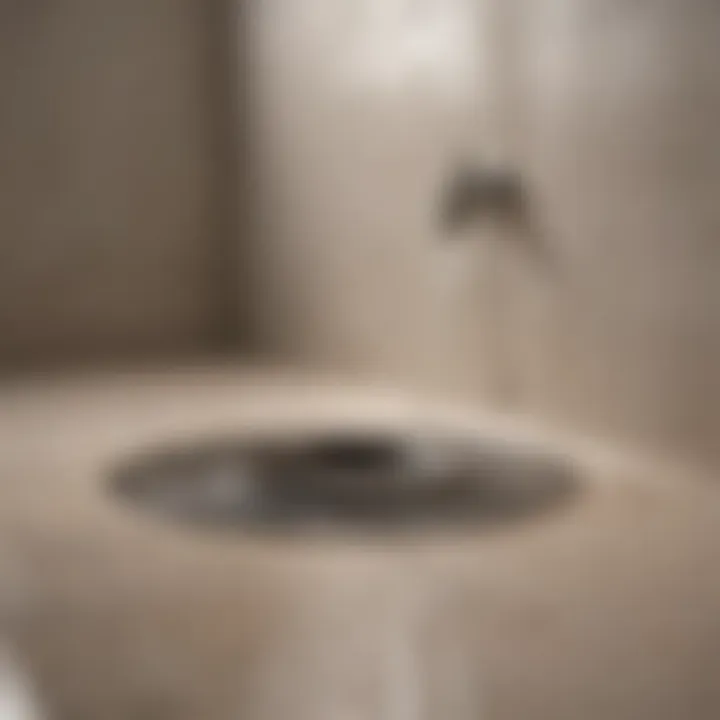
Inserting the drain snake is the first significant action in the snaking process. Selecting the right size and type of snake is important for the effectiveness of the operation. Generally, it's best to start with a hand-crank snake or a motorized snake if the clog is tough. The snake should be inserted carefully into the drain opening.
Before inserting, it is wise to remove the drain cover if applicable. This access makes it easier to maneuver. Once ready, push the snake gently into the drain, making sure not to force it. Feeling or hearing resistance? This may indicate a clog. At this point, continue to advance slowly while turning the handle clockwise. This rotational motion allows the snake to navigate into the blockage.
Navigating Curves in the Drain Line
Most drains contain bends and curves, and navigation through these segments can present a challenge. Understanding how to maneuver around these curves is critical as it keeps the snake from getting stuck or damaging the pipes. Introducing slight pressure while turning the handle can guide the snake smoothly around these turns. If resistance occurs, do not force it; instead, retract slightly while continuing the rotation. This motion can help free the snake from any tight spaces.
Sometimes, when encountering a curve, it can be useful to analyze if you are using the appropriate type of snake for the job. A flexible drain snake may be needed for extreme bends, as this equipment is designed to bend without losing effectiveness.
Removing Clogs Effectively
Once the snake has navigated through the curves and encountered the blockage, the next step is effectively removing the clog. When a solid resistance is felt, it's often a signal that the snake has made contact with the blockage. Utilize a gentle yet firm twisting motion to break up the clog. If the material is soft, this action may be enough to dislodge it completely.
If the initial resistance is from hair or build-up, it often wraps around the snake, making removal challenging. In this case, pulling the snake back slightly to catch the debris may be effective.
After dislodging the clog, fully retract the snake from the drain while carefully examining the removed material. This provides insight into what caused the blockage and allows you to take preventative measures in the future.
Properly executed, the snaking process returns your shower drain to optimal functionality, reducing future clogs and ensuring proper drainage.
By combining these methods effectively, homeowners will not only address current blockages but also shoulder the responsibility of knowing how to maintain drains proactively. This preventative knowledge is key in creating a reliable drainage system.
After the Snaking Procedure
Once you have successfully completed the snaking process, it is crucial to evaluate the effectiveness of your efforts. This phase encompasses analyzing the current state of the shower drain and undertaking necessary steps to maintain it moving forward. The purpose of this section is to emphasize the relevance of reassessing drain functionality and establishing a maintenance routine.
Testing Drain Functionality
Testing the drain functionality involves a systematic approach to ensure that all clogs have been effectively removed and water flows freely. Begin by running water at a moderate pace and observing how quickly it drains. Pay attention to any lingering slow spots or pooling, as these symptoms indicate that the snaking may not have fully resolved the clog.
To perform a thorough test, consider the following steps:
- Run the Water: Open the faucet to let water flow into the shower. Ensure the temperature is consistent with regular use.
- Observe Drainage: Watch how the water retreats into the drain. Ideally, it should disappear swiftly without any obstruction.
- Check for Sounds: Listen to any unusual gurgling or bubbling noises emanating from the drain, as these might suggest trapped air or remaining debris.
- Repeat If Necessary: In cases where the water does not drain efficiently, it may be wise to repeat the snaking process or investigate other potential blockages further down the line.
A successful drain test confirms that the snaking process was beneficial, ensuring your shower is once again usable without interruption.
Maintaining Clear Drains
Once the shower drain has been cleared and functionality is restored, ongoing maintenance is vital for ensuring continued optimal performance. Prevention is more effective than cure, and implementing a regular cleaning routine can significantly reduce the risk of future clogs.
Here are several simple techniques for maintaining your drains:
- Regular Cleaning: Schedule routine cleanings to prevent the accumulation of hair, soap scum, and other debris. Consider using a drain strainer to catch hair and larger particles.
- Use Natural Cleaners: Employ safe and effective DIY solutions, such as baking soda and vinegar. This combination can help dislodge minor buildups without the use of harsh chemicals.
- Monitor Water Flow: Regularly check how quickly water drains during every shower. Notice any changes in flow rate and consider that a warning sign for potential blockages.
In summary, addressing the needs after snaking a shower drain is key to promoting a healthy plumbing system. Testing the functionality ensures that the work performed was successful, while consistent maintenance techniques serve to fortify against future issues.
"An ounce of prevention is worth a pound of cure."
Following these guidelines will not only facilitate the longevity of your shower drain but also enhance your overall bathroom experience.
Common Drain Snaking Mistakes
When addressing the issue of clogged shower drains, it is essential to understand common drain snaking mistakes. The significance of this topic lies in the fact that the improper use of tools can lead to ineffective results and possible damage to plumbing systems. By familiarizing oneself with these errors, homeowners can ensure more efficient results during the snaking process. Additionally, learning from past mistakes can save time and reduce future plumbing issues, contributing to a more effective maintenance routine.
Overusing the Drain Snake
One prevalent mistake when snaking a drain is overusing the drain snake. Homeowners may feel that excessive use of this tool will clear blockages faster. However, this approach often leads to more problems. Overly aggressive snaking can cause harm to the drain pipes, potentially resulting in cracks or valuable misalignments. Forcing the snake through stubborn clogs may also push debris farther down the line, making the blockage even worse. Instead, it is wiser to limit snake usage and consider other methods, such as using a plumbing auger or a combination of hot water and vinegar to dissolve less severe clogs.


Ignoring Underlying Issues
Another common mistake is ignoring underlying issues that lead to repeated clogs. Many homeowners focus solely on removing a blockage temporarily, without addressing the root cause. Hair, soap residue, and foreign materials often pile up, creating chronic issues if not properly managed. Ignoring these problems may result in consistent drain troubles. It is crucial to inspect for recurring blockages and explore preventive measures. Regular maintenance, such as cleaning the drain and using specific covers designed to catch debris, plays an essential role in avoiding such problems. By acknowledging potential underlying issues, homeowners can enhance the long-term performance of their shower drains.
When to Call a Professional
Knowing when to call a professional for plumbing issues can save time, money, and potential damage to your home. While snaking a shower drain can be a viable solution for minor clogs, there are instances where professional intervention becomes essential. Recognizing these situations will help maintain your plumbing system and prevent further complications.
Signs of Severe Clogs
Some clogs may be more serious than they initially appear. Here are a few indicators that suggest it is time to enlist the help of a professional plumber:
- Consistent Backups: If your shower consistently backs up, even after snaking, this may indicate a blockage further down the line.
- Multiple Fixtures Affected: If more than just the shower is experiencing drainage issues, such as sinks or toilets, it may signify a main line issue.
- Unpleasant Odors: Persistent foul smells coming from the drain might indicate decomposing material deep within the pipes, requiring specialized equipment for removal.
- Water Drainage Speed: If water drains slowly, it often signifies a larger obstruction that DIY methods cannot easily resolve.
- Visible Damage: If you notice cracks or leaks around the plumbing fixtures, calling a professional is important to avoid water damage.
If you encounter these issues, contact a licensed plumber to evaluate the situation. They have the tools and expertise to handle severe clogs that a basic home remedy cannot.
Evaluating Long-Term Solutions
If clogs are a recurring problem in the shower or other plumbing fixtures, it might be time to consider long-term solutions. A professional plumber can conduct a thorough evaluation of your plumbing system, which may involve:
- Camera Inspection: This technique uses small cameras to examine the inside of pipes, identifying the precise location and nature of blockages.
- Professional Snaking: Specialized tools can tackle stubborn stoppages that a standard drain snake may not resolve.
- Pipe Relining or Replacement: In severe cases, damaged pipes may need relining or replacing, which can help prevent future problems.
- Regular Maintenance Agreements: Establishing a routine check-up schedule can help catch issues before they escalate, enhancing the longevity of your plumbing system.
Preventative Maintenance Techniques
Preventative maintenance techniques are essential in ensuring the longevity and functionality of shower drains. By effectively managing typical issues before they develop into serious clogs, homeowners can avoid costly repairs and the frustration associated with blocked drains.
This section will illustrate the significance of adopting such techniques and highlight specific practices that promote efficient drainage.
Regular Cleaning Routines
Establishing a consistent cleaning routine for your shower drain cannot be overstated. By engaging in regular cleaning, you remove hair, soap scum, and other debris that tend to accumulate over time. This simple step helps to maintain smooth water flow and can significantly reduce the chance of clogs.
A few practices to consider include follow:
- Bi-weekly Hair Removal: Making a habit of removing hair from the drain every two weeks can go a long way in preventing blockages.
- Monthly Deep Clean: Apply a mixture of vinegar and baking soda down the drain monthly. This helps to break down build-up and keeps the drain smelling fresh.
- Inspection: Regularly check for signs of trouble, such as slow drainages or unusual odors, which could indicate potential clogs.
These regular tasks are not time-consuming but are pivotal in enhancing the effectiveness of your drainage system.
Choosing the Right Drain Cover
Selecting an appropriate drain cover is another critical aspect of preventative maintenance. The right drain cover can trap debris before it enters the plumbing system, acting as the first line of defense against clogs.
When choosing a drain cover, consider the following elements:
- Size Compatibility: Ensure the cover fits securely over the drain. A cover that is too loose may not do its job correctly.
- Material Durability: Opt for high-quality materials that resist rust and corrosion. Stainless steel or durable plastic options are often preferable for long-term use.
- Design Features: Look for covers that have small holes or grates to allow water to flow freely while preventing larger debris from passing through.
In additon, finding a cover that harmonizes with the overall aesthetics of your bathroom can enhance the visual appeal while serving its practical purpose.
By investing in effective preventative maintenance techniques, you can ensure that your shower drain operates optimally for years to come.
Culmination
In this article, we have explored various aspects of snaking a shower drain. The concluding section highlights the crucial importance of proper maintenance of drainage systems, particularly in residential settings. One key takeaway is that regular attention to drains can prevent more serious problems from developing. A well-maintained shower drain not only enhances the functionality of the bathroom but also improves hygiene by minimizing odors and promoting better water flow.
The Benefits of Proper Drain Maintenance
Maintaining drains goes beyond just the immediate concern of clogs. The benefits are multi-faceted:
- Prevention of Clogs: Regular cleaning reduces buildup of hair and other debris, decreasing the likelihood of blockages.
- Extended Longevity: Proper care can extend the life of plumbing systems, saving homeowners costly repairs in the long run.
- Improved Hygiene: A clean drain contributes to a healthier environment by minimizing mold growth and unpleasant smells.
- Increased Property Value: Well-maintained properties often have better market value. Clean drains reflect good overall home care.
Overall, prioritizing drain maintenance creates a more efficient home and can enhance a homeowner's quality of life.
Final Thoughts on DIY Drain Snaking
When considering DIY drain snaking, it is imperative to approach the task with careful planning and an appreciation for the processes involved. Understanding the tools and their uses is vital, as is being aware of one's own limitations.
Many will benefit from learning how to effectively snake a drain, as it is a cost-effective solution that can address minor clogs without professional assistance. Basic knowledge about the snaking procedure empowers homeowners to take control over their maintenance tasks. However, it is essential to recognize when a problem persists despite efforts. In such cases, engaging a professional might be the most prudent course of action.
DIY drain snaking can foster confidence and knowledge when performed correctly, contributing to long-term property care.







